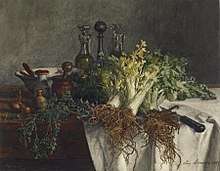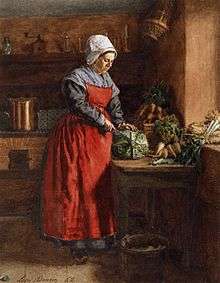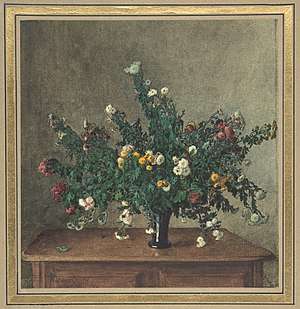Léon Bonvin
Charles Léon Bonvin (February 28, 1834 – January 30, 1866) was a French watercolor artist known for genre painting, realist still life and delicate and melancholic landscapes.

Biography
Bonvin was born in Vaugirard (at the time a municipality on the outskirts of Paris, today part of the city) in humble circumstances. He was the son of a constable and a seamstress who owned a poor guinguette. He had numerous siblings and lived in a barren plain; the household money was scarce.
As a young boy he began making small charcoal sketches, and gradually ink drawings. His older step brother François Bonvin encouraged him to continue and provided him with paints and the advice to carefully study the old masters of the Dutch Golden Age.
He probably attended some of the free classes offered by l'École royale gratuite de dessin created by Bachelier[1][2] but was mostly self-taught. He also learned to play music on a harmonium.
In 1861 Bonvin married, soon had children, and worked as an innkeeper. The young couple struggled; the inn lost money; anguish set in. Yet painting in the stillness of early morning, at dusk or at night, Bonvin was able to create numerous genre paintings echoing the manner of Jean Siméon Chardin, meticulous still life studied with the precision of a botanist and subtle landscapes capturing fleeting atmospheric effects and solitude. These were mostly fragile watercolors for affordability reasons, oil paints being more expensive.
He approached gallerists on rue Laffitte and rue du Bac, but he made few sales of his watercolors. In January 1866, Bonvin traveled to Paris again to offer his watercolors to a dealer, who rejected them as too dark. Desperate, he hung himself the next day in the forest, on January 30, 1866, and was discovered a few days later; he was 32 years of age.[3]
 Léon Bonvin - Cook with Red Apron - Walters 371505
Léon Bonvin - Cook with Red Apron - Walters 371505.jpg) Léon Bonvin - Still Life - Basket of Grapes, Walnuts, and Knife - Walters 371529
Léon Bonvin - Still Life - Basket of Grapes, Walnuts, and Knife - Walters 371529.jpg) Léon Bonvin - The Country Inn - Walters 371671
Léon Bonvin - The Country Inn - Walters 371671 Léon Bonvin - Bouquet of Small Chrysanthemums - Metropolitan Museum of Art 1996.296
Léon Bonvin - Bouquet of Small Chrysanthemums - Metropolitan Museum of Art 1996.296
Posterity
At the initiative of his step brother François, because of the dire circumstances in which his family was left, a special art sale of his works was organized to raise money, with artists donating their own works as well; these included Claude Monet, Henri Fantin-Latour, and Johan Barthold Jongkind, among many others "who must have been aware of the quality of Léon’s art or knew his brother François Bonvin".[4]
The special sale took place at the Hôtel Drouot in Paris on May 24, 1866.[5]
Art historian Gabriel P. Weisberg, in Léon Bonvin's Realism revisited, Chicago Journals writes :[4]
"What has been advanced here is that others recognized the significance of both artists at the time, although it was François who generated more discussion since he lived longer, completed oil paintings, and was a regular exhibitor at the Paris Salon. Léon Bonvin's watercolors capture a sense of the ineffable with a delicacy that belies the destitute circumstances of his daily life. Seeing just a few of his watercolors is spellbinding and haunting."
Among the collectors interested in Bonvin’work, William T. Walters, father of Henry Walters, founder of the Walters Art Museum, who acquired some of Bonvin’s fragile works. His collection eventually comprised 56 watercolors and one, rare oil.[6] Today, it is the largest collection of Bonvin's work in existence.
In recent Christie’s auctions (2007, 2016), a landscape and a self-portrait by Bonvin reached a sale price noticeably above estimates.[7][8]
Collections
Bibliography
- Gabriel P. Weisberg, William R. Johnston : The Drawings and Water Colors of Leon Bonvin, Cleveland Museum of Art, 02/01/1981, ISBN 9780910386623
References
- "BONVIN, Léon (1834 - 1866), Painter, watercolourist, musician : Benezit Dictionary of Artists - oi". doi:10.1093/benz/9780199773787.article.b00022964. Cite journal requires
|journal=(help) - (fr)Bnf, data
- "Léon Bonvin - Fallen stars". ResearchGate.
- Weisberg, Gabriel P. "Léon Bonvin's Realism Revisited". Source: Notes in the History of Art. 36 (1): 38–48. doi:10.1086/691364.
- (fr)Gallica, BnF, French archives in La Chronique des arts, 1866-04-29, page 134
- Museum, The Walters Art. "Near Paris: The Watercolors of Léon Bonvin".
- "Léon Bonvin (1834-1866), La plaine de Vaugirard". www.christies.com.
- "Léon Bonvin (Paris 1834-1866 Meudon), Self-portrait". www.christies.com.
- "Léon Bonvin". The Walters Art Museum · Works of Art.
- "Léon Bonvin - Bouquet of Small Chrysanthemums - The Met". The Metropolitan Museum of Art, i.e. The Met Museum.
- "Léon Bonvin (French, 1834 - 1866) (Getty Museum)". The J. Paul Getty in Los Angeles.
- "Léon Bonvin". 22 August 2014.
- "Léon Bonvin | Landscape with a Farmhouse and a Peasant Wheeling a Barrow | Museum of Fine Arts, Houston | Buy Prints Online". 1000museums.com. Retrieved 2017-09-14.
- "Joconde - catalogue - dictionnaires". www.culture.gouv.fr.